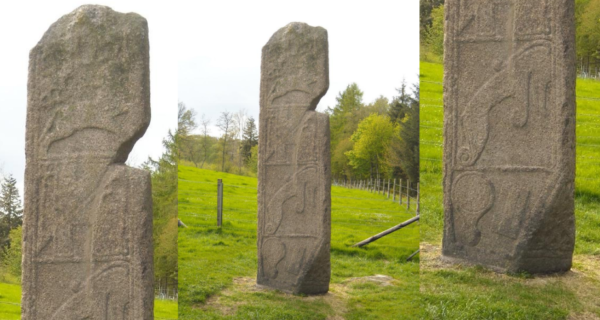The Maiden Stone (pictured above) is one of the most well-preserved examples of Pictish monuments (monuments of the Picts, a group of Celtic tribes indigenous to the northern and eastern parts of Scotland). Standing at 3.2 metres high, made entirely of granite, and dating to around the 9th century AD it depicts an array of symbols ranging from a ring headed Celtic cross (viewed on the rear side of this monument) to carvings of animals and mythical beasts (such as centaurs and what appears to be a fish/dolphin-like creature), in fact, even the sides are carved with a fine geometrical interwoven design. The Maiden Stone was completed sometime in the 800s and was carved with Celtic symbology on one side, and more traditional Pictish designs on the other.
Although the meaning of the symbols displayed on such monuments has been somewhat lost over time, the relevance of such sites has been much theorised/debated by archaeologists, historians, and the general public for many years. However, the main interpretation (theory) as to the relevance of the Maiden Stone in its ‘heyday’ is that it was erected as a memorial to a chief/noble or other equivalent person of importance in the Pictish community, and to act as a reinforcement to the claim of the land around the stone for the said person’s heirs. “Although many theories have been devised to explain the symbol stones… erected as personal memorials, showing the rank of a recently deceased chief or other prominent person, and also giving to his descendants a form of title or claim to the land around the stone.” (Aberdeen Council: unknown date).
I believe this site to be of key importance in the understanding of our past and past societies as sites such as the Maiden Stone, which is relatively well preserved compared to similar sites, raise many questions (such as why this site was important, what the inscriptions and even the stone itself means etc) and may be key in finding answers to these questions, through correlations, interpretation, examination, and other such archaeological methods, therefore helping to piece together the information of our past.
Although one could argue that sites such as that of Loanhead of Daviot or the Inverurie churchyard are also of key significance in the interpretation of the past, it is my belief that the Maiden Stone is the most important of the archaeological sites that we visited.
This is due to the fact that the Maiden Stone and more specifically the inscriptions carved into it, more so than the other sites, raise and may even be the key to answering such questions as the relevance of this site to the Pictish people, the written language (through the use of symbols), the beliefs, the culture and other important information about the Pictish culture/society, thereby helping to piece together the accounts/heritage of our past.

